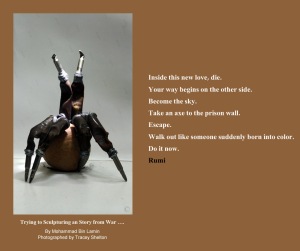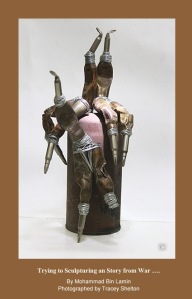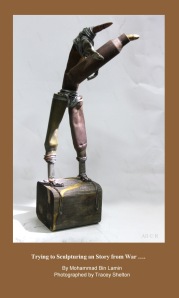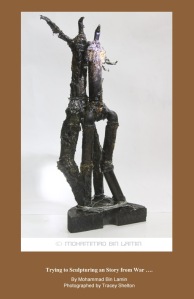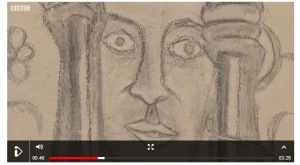( Season’s Greetings )
R U S T – A R T
© Mohammad Bin Lamin
www.binlaminart.com/
Season’s Greetings
December 24, 2014
مع وقف الوطن
December 24, 2014
Poem Binlamin, Child, Libya, Misurata, Photos, Poem, War, writers Leave a comment
التي تتحرش ببقايا النار
وتتحسس فولاذ الحرب
الذي برد للتو
واتقد للتو
اليد الصغيرة وأعني بها
أنامل الحناء
وابنتي تقول بايا هذا حديد
وانا أقول في نفسي
بأس شديد
وننظر سوية إلى السماء
ربما يخالجني أو يخالجها
أن الشمس حديد والقمر حديد
والطائر الذي يصدر صوتا عظيما
وله أزيز مرعب
قد يرسم على شفاهنا توهما
ابتسامات غير مؤكدة
مع وقف القصف
مع وقف الوطن
ووسوسة الرحيل والهرب الجارح
أقول ها بنيتي كفي
عن تقبيل هذا المعدن الأسود
فقد سال عليه دم كثير
وكم “عمو” مات لكي تعيشي
أنت وأختك الأخرى
تعالي أشتري لك شوكلاتة
علكة بودرية
بسكويت بعجوة من مكة
أخيرا ننجح في مغادرة سلطة المشهد
وأجدني أمسح عن شفتيها
بقايا السكاكر
بمنديل ورقي ناصع البياض ….
* مصراته – 21 ديسمبر 2014
بن الأمين
— in Misratah, Libya.
Sculptures of Bullets
September 24, 2013
Artist Art, Artist, Bullets, fine art, Libya, MBL, Sculptures, War Leave a comment
By Libyan Artist: Mohammad Bin Lamin
Photed By André Liohn
http://www.binlaminart.com/
موقف أقفاص الحمام
September 24, 2013
Mohammad Bin Lamin 43, Artist/Sculptor, Misrata From The Book: Shabab Altoura: Their Story By: Tracey Shelton
January 5, 2013
Artist 17.feb, Abu Salim, Artist, Artists, Artworks, Binlamin, fine art, Gaddafi regime, Libya, MBL, Misurata, Mohammad, Sculptures, War Leave a comment
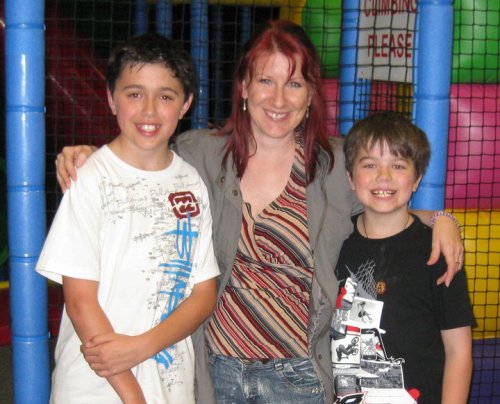
On the night of February 20, 2011, Mohammad Bin Lamin knelt
before his captures. A black hood covered his head. He heard the
click as they loaded the gun and told him he was about to die.
“It was a horrible night,” was his only comment on the terror that
must have consumed him. He had been arrested along with his brother Habib on February 16, the night before anti-government protests broke out across the country. The Lamin family was well known for their anti-government stand. Mohammad had been active in denouncing the government and calling for protests on Facebook.
“The first step for the Gaddafi regime was to try to catch people who could be active in starting a revolution,” Mohammad said.
Police, led by Mohammad’s neighbor, a “notorious bad guy”, broke into the art gallery and workshop where Mohammad has spent more than a decade creating sculptures and paintings.
The brothers were taken to Abu Salim, the most notorious prison in Libya. The mock execution took place several days later.
Mohammad was born in 1969, the year Gaddafi took power.
“They told me I of all people should be grateful to Gaddafi for the country I was born in to,” Mohammad said. “I am the whole story of Gaddafi’s reign – my body, my soul can attest to his tyranny.” Mohammad survived the night and was returned to his tiny cell that he shared with his brother.
Prisoners were only allowed out of their cells for interrogation.
Desperate for a creative outlet Mohammad began sculpting his
aluminum food trays into portraits of fellow inmates and jailers, and using them as pens to draw on his cell walls. Mohammad said he was confronted about his drawings several times but mostly they were too busy to notice.
“Some were Ok, but most of them were not human. Especially when they had bad news about a Thuwar [revolutionary] advance. They would open the cells and start kicking and beating us. Other times we would hear NATO bombing outside and cry ‘Allah Akbar’ – God is greatest – so they would punish us.” News slowly filtered in through new prisoners. Whispered messages were passed from cell to cell.
“We heard the noises of war around us. We were sure Tripoli would fall but we did not know what our fate would be. Would they kill us all? Would the rebels reach us in time?”
On August 23, more than six months after Mohammad’s arrest, the guards fled Abu Salim. The following day, the rebels arrived.
“We heard the cry of Allah Akbar so we knew it was real,” Mohammad recalled.
The following day, Mohammad was reunited to his family who had for 6 months feared he had already been executed. After a decade of trying to have children Mohammad found himself reunited with a very pregnant wife. She had discovered her pregnancy shortly after Mohammad’s arrest.
On October 8, the week before Gaddafi’s capture and death she
gave birth to twin girls. “My daughters are a gift from God, my treatment for all my pain. When I look into their eyes I can forget all things.”
Mohammad now makes artwork from remnants of war, sculpting
objects designed to kill into symbols of love and beauty.
—————————————–
1- Abu Salim Prison
“I shared this cell with my brother. I used our aluminuim food containers as pencils to draw on the walls. When I ran out of
space I remember wishing they’d change my cell so I would have more space to draw,” Mohammad Bin Lamin
2- “I drew the prison cell surrounded
by flowers as a symbol of hope.
When the guards looked through
the window of our cell door they
would see this image. I wanted them
to know that I am not sad, but it was
an honor to be here for Libya,”
Mohammad Bin Lamin.
3- “Sculpting from remnants of war is about
transforming something created to kill into
something of beauty – a symbol of love,
dance, humanity,”
Mohammad Bin Lamin
This piece shows the cross section of a 14.5mm anti aircraft
bullet. The crystal is from the Libyan dessert.
4- Soldiers
This piece is called the collapse of the
genocide battalions. It represents Gaddafi’s
troops as they were defeated by the
revolutionaries,” Mohammad Bin Lamin
5- The pieces are not rigid and Mohammad
spends hours rearranging each piece to
create different scenes.
6- “I like to incorporate objects of Libyan history in my work. For this piece I used an ancient stone from the Southern Libyan desert,”
Mohammad Bin Lamin
7- “This is part of a series that represents the Libyan
rebel fighters. In this piece you see a fighter
facing amputation,” Mohammad Bin Lamin
8- “I call this series Dance in Angelical Orbit,” Mohammad Bin Lamin
9- “This series represents the bond
between a mother and child
and the way a mother will
protect her children from
danger in any crisis,”
Mohammad Bin Lamin
10-Faces of War
“This is part of a Beretta gun that was struck
by NATO in a store house for Gaddafi’s men.
I liked the face that appeared in the ruins,”
Mohammad Bin Lamin
11- “This is part of a Beretta gun
that was struck by NATO in a
store house for Gaddafi’s men.
I liked the face that appeared
in the ruins,”
Mohammad Bin Lamin
12- “My daughters are a gift from
God, my treatment for all my
pain. When I look into their
eyes I can forget all things,”
Mohammad Bin Lamin
Inside the notorious Abu Salim jail
August 21, 2012
Abu Salim prison, Art, Art in prison, Artist, drawings, Libya, Libyan revolution Abu- Salim-prison, Art, Art in prison, Artist, Binlamin, Drawings, Libya, Libyan Revolution Leave a comment
http://www.bbc.co.uk/news/world-africa-14755667
Colonel Gaddafi has called for Libya to be “engulfed in flames” in an audio message carried by a loyalist TV channel.
In Tripoli, human rights workers are trying to salvage records from inside Libya’s most notorious prison, Abu Salim.
Over the course of several decades, thousands of Libyans are said to have been jailed and tortured in the prison by members of the Gaddafi regime.
Jeremy Bowen reports from Tripoli.
In the beginning
August 20, 2012
Art, Artist, Libya, Love, Poem, writers Art, Binlamin, Love, Poem, writers 1 Comment
|
In the beginning were the rustling leaves of the forbidden tree, In the beginning were the creaking doors of the greater universe, In the beginning were the “things” hurting by “Things” In the beginning was a bang on the head, then the initiation, etc… along the way. Mohammad Bin Lamin
|
The Three Eras for a dream
August 19, 2012
Art, Artist, Poem Art Shade, Artist, Artists, Arts, Artworks, Binlamin, Libya, Misurata, Mohammad Bin Lamin, Paintings, Poem, poetry, Solara Sabah Leave a comment
The Three Eras for a dream
Poem and Artworks By: Mohammad Bin Lamin.
Translated from Arabic by: Solara Sabah.
1. The Amulet Time
His blue Amulet did not save him from the act of the sea,
neither did the white one.
They did not soothed him from the flares of
the land.
They did not stop the temptation of the waves
and the curse of whiteness or cured him from the sun’s ailments.
He was saved by the worries of the mothers who were
lingering near the oven to steal from it the mercy of the bread.
Or maybe he was saved by the mother’s supplications in the half darkness
behind the spindle of the wool’s mats,
praying to God to safeguard him
from the Beasts of the darkness,
the evil eyes, and the ferocity of the envy.
2. The Solitude Time
And you’re a very obdurate!
You have never been bind by phylactery or by Fakih’s mantra
you saved your steps
for the mint fragrance road and the accompaniment clouds.
Holding back your right hand
to greet the person of your dream,
To embrace the surface of the water,
Promising your heart to meet the spring and the temptation of the daffodils,
Rolling your eyes inside,
Laughing and crying.
Lighting the daytime by the sun,
Dripping the stars in the night,
and dangling from the moon!
Obstinately in love.
Your dream has taken by your pride
Descending into the illusion that one day it will come
with a dark eyes
elegant and tall
with a small bird hovering on the head.
Wandering,
Dancing and asking for the mercy.
The dance of the slaughterous
The mercy of the dust,
A resurgence of desperate love!
3. The Exudes Time
Hold on tight to your luggage!
You have to endorse your travel,
the nudge of the stations,
The noisiness of the railroads crossings;
and the dreariness of the passages and the tunnels.
Flying and sailing.Mingling with foreign seaports,
The dead dreams and the glasses of wanderers wine.
Dancers floating in the drum of the water.
The first lament for the homelandlurking from under the feet.
Where ever you go the land looks the same.
Strange as it should be,
You will never be familiar with this existing world.
you will be welcomed by the uncertainty of the empty rooms,
the shared houses,
the dispirited parks
And the ugly elderly women
The owners of the homes who will prohibited you from being late at night.
Just be as you are
lost between the distractions of the eyes and the lust of the dreams.
poor fellow as in the prayer.
Knight at the wedding extravaganza.
Taken by different visions,
and the fluctuated news.
Slaughtered by friends knifes
and deceived by the wooden rifles
How will you enjoy the night
As they do each day?
And how the moon complains of its nostalgia for the beautiful face?
You are doomed!
consumed by the timeas a coffee drunk in a hurry .
Blown by the wind as a nuisance Southern dust,
that will never whisk off by the country broom
Wake up and go on!
Your cold hands and these doors cannot endure the knocking,
neither the ceiling and the walls,
Forsake this dream of yours
and leave as those who left before you,
No need for the blame
Just wait with patience and eternal gaze.
August 19, 2012
It was while we were in one cell that we found the most beautiful and inspiring art that had been drawn on the walls as a symbol of defiance. The words read “The Future will be us” – and in the words of Omar Muktar – the famous resistance rebel who led the resistance movement against Italian occupation – “We win or we die.” Such fitting words for the rebel resistance that was now the Libyan civil war. But what was most touching was the final inscription – surely a retort to Gaddafi and a reference to him wanting to be the “King of Kings” – “If you want to be a King, first you should be a man.” I could see the art work was signed by a Misratan named “Mohammad bin Lamin” and I resolved myself to find this man (if he was still alive) and film his story. It wasn’t till be second visit to Libya that I discovered he was alive and well and was in fact arrested with his brother in Misrata by Gaddafi’s forces at the very beginning of the uprising on February 15. He spent the whole of the Revolution jailed in Abu Salem. I hope to meet him one day and film his story. Whilst sat in a hotel room in Tripoli during another visit I saw his remarkable story filmed for Al Jazeera English. Using art as a spiritual answer to daily repression, Mohammad is a symbol of enduring resistance to the rule of Gaddafi.
By Sharron Ward.
December 2011: I was standing in the heat of the midday sun, waiting for Ziad to come and pick me up. I had taken shelter by a small wall, in the grounds of the Corinthia Hotel – one of the few 5 star hotels in Tripoli – most notably known for the amount of NTC members and foreign dignitaries staying there. It was one of the few places people went to get a decent internet connection and a “proper” cappuccino. As I was filming, I marvelled at the sheer amount of traffic driving past. Gaddafi had never invested in any kind of public transport system and so Libyans drove everywhere. This resulted in horrendous traffic jams, and I watched as one lone police officer on duty tried to bring some semblance of order (he was one of the very few brave enough to come back on…
View original post 1,571 more words
A tale of a Libyan artist
August 13, 2012
Al Jazeera, Art, Art in prison, Artist, bullets, drawings, Libya, Libyan revolution 17.feb, 24 Agust, Al Jazeera English, Art, Art in The prison. Abu Saleim prison, Arts, Binlamin, Freedom, Libya, Libya Free, Misurata, Mohammad, Paintings, prison, revolution, Tahleel, Takbeer, Tv, Twins, War Leave a comment
View The Video:
http://www.aljazeera.com/video/middleeast/2012/07/201271483939185732.html
Mohammad bin Lamin used art to survive his time in prison before he was set free after the revolution.
Al Jazeera talks to Libyan artist Mohammad bin Lamin who used art to survive his time in prison before the country’s revolution.
From drawing on his prison cell walls with whatever he could find to his post-revolutionary art including sculptures made from used bullets and shells, bin Lamin hopes his art will offer a spiritual answer for the daily oppression around the world.







